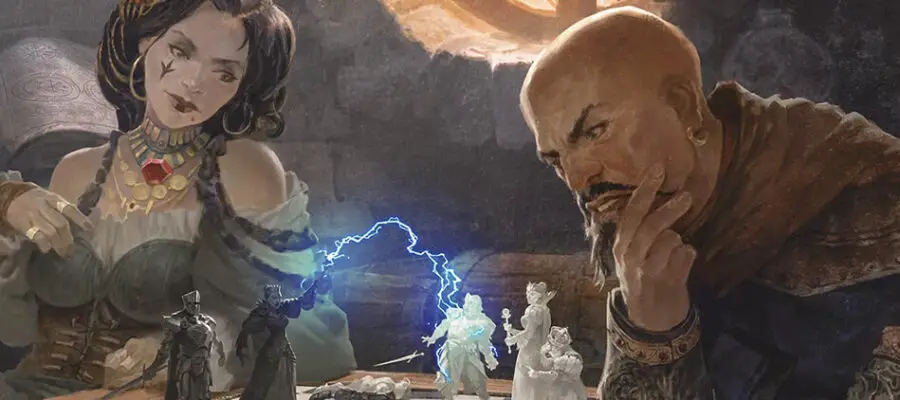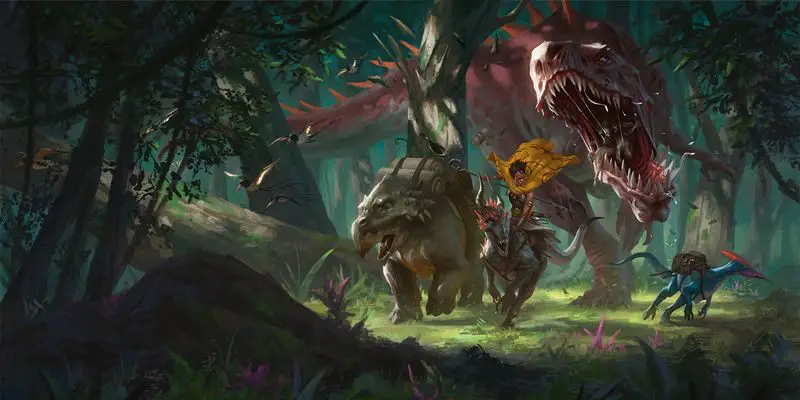Featured image for engaging players with dramatic questions is property of Wizards of the Coast and illustrated by Svetlin Velinov in Tasha’s Cauldron of Everything.
Disclaimer: This article contains affiliate links that add gold to our coffers.
Five adventurers ride a wagon to a distant city. Suddenly, screams of rage echo through the prairie as four revenants charge from the underbrush. The adventurers try to parlay, but to no avail—it is kill or be killed.
So began a random encounter that a new DM once ran for our party. While running a campaign module, he rolled on the book’s Random Encounter table, sketched out a battlemap, and said, “Roll initiative!”
The revenants came out of nowhere, with no backstory, purpose, or motivation beyond homicidal rage. It was a long slog—two characters nearly died—but after ninety minutes of combat, our heroes finally came out on top. Afterward, I asked him why he’d run the encounter the way he did. “It was in the book,” he said, and shrugged helplessly.
Dungeons & Dragons 5e teaches players a lot about the nuts-and-bolts of dungeon-, character-, and encounter-building. It offers oodles of options for spells, feats, and mechanics. However, it does little to teach DMs how to engage their players with dramatic quests and encounters. If you’re looking to keep your D&D players engaged—and if you’re looking to build a satisfying combat encounter or non-combat scene—we must first explore a fundamental concept of storytelling: the dramatic question.
What is a Dramatic Question?
In fiction, the “dramatic question” summarizes the protagonist’s central conflict. In the Odyssey, the dramatic question is simple: “Will Odysseus safely return home from Troy?” In Harry Potter, the dramatic question is a bit more complex: “Will Harry and his friends survive the school year and stop Voldemort’s latest evil scheme?” For both cases, the storyteller creates a dramatic question that makes the reader want to answer “Yes!”—and then creates suspense by posing obstacles to that question’s resolution.
In Dungeons & Dragons, there is no reader and no single storyteller. However, the DM is indisputably the game’s central story-setter: posing dramatic questions (and obstacles), and then allowing the players to decide how those questions are resolved.
A single storyline may include multiple, smaller stories, each with their own dramatic question. In the first chapter of The Lost Mine of Phandelver, the question is: Will the PCs rescue their missing friend from the goblins’ clutches?
As the PCs explore the goblin hideout, this dramatic question sprouts additional heads: Will the PCs survive the goblin ambush? Can the PCs avoid the sentries and silence the hungry wolves? Can the PCs free the goblins’ hostage—and defeat the bugbear that leads them?
A dramatic question is not the same thing as a “linear storyline” or “railroad.” The question is always the players’ to answer, not the DM’s. While campaigns can be linear or sandbox-y, a dramatic question is often essential to a satisfying campaign. We DMs must pose three fundamental questions to capture our players’ attention: “What are we doing?”; “Why are we here?”; and “Why should I care?” Whether you’re building a D&D encounter or questline, a good dramatic question answers all three.
Let’s return to the revenant example from above. Even if the DM had fine-tuned its setpiece and mechanics, he would have struggled to answer these questions, leaving its dramatic question thin and stringy. “Will the PCs survive the revenant attack and continue on their journey?” is a dramatic question, but not a particularly interesting one.
We can strengthen dramatic questions by inviting complex answers. In The Odyssey, Homer does just that: Can Odysseus free his men from Circe’s curse? Can Odysseus safely navigate the sea between Scylla and Charybdis? Can Odysseus fool the cyclops Polyphemus and escape the wrath of his neighbors? Here, perhaps the revenants are victims of an ancient curse that binds their souls to this road—and now, the PCs are, too. (“Can the PCs discover the curse’s secret and escape its wrath?”)
We can also strengthen dramatic questions by making them personal. Perhaps the revenants have key knowledge relating to the PCs’ quest. (“Can the PCs calm the revenants’ tempers and gain their hidden knowledge?”). Perhaps they’re employed by the PCs’ enemies. (“Can the PCs’ survive the villain’s assassins?”).
Dramatic questions extend far beyond random encounters. Imagine a wizard haggling with a shopkeep over a wand of magic missile while the fighter sighs with boredom. The wizard has an engaging dramatic question (“Can I get the merchant to sell me this wand for a big discount?”), but the fighter has nothing—no stake in the outcome and no meaningful way to impact it.
When a player’s attention starts slipping, it’s worth asking yourself: Does the current scene offer this player a dramatic question? If the answer is “no,” it might be best to improvise a way to bring that player into the scene—or bring the scene to a swift and painless end.
The same is true for open-ended areas and storylines. If all options are equal, “Where would you like to go?” is a meaningless question. Too many sandboxes have sunk for want of a dramatic question. Too many narratives have starved for want of proper stakes. A hook is not a hook without bait.
Creating Dramatic Questions
As DMs, we can draw our dramatic questions from three main sources: our scenes, our players, and our worlds:
Scene-Driven. A D&D scene or encounter without a clear conflict, challenge, or antagonist is often limp and aimless, especially if your players are running errands or transitioning from one place to another. While your group may enjoy infusing these scenes with atmosphere or characterization, consider also posing a dramatic question. (“The shopkeep will sell you his goods—but he’s a slick snake-oil salesman with an enticing pitch.” “The enchanted wood leads to the gnomes’ secret village—but the forest is full of false paths and clues, and each wasted minute draws you further into the Feywild.”) If you can’t introduce a dramatic question to a scene or sequence—for example, because it has minimal importance to the plot—consider skipping the scene entirely with a quick summary or montage.
Player-Driven. As DM, you presumably want your players to have fun. Accordingly, it might make sense to draw dramatic questions from the ideas and narratives your players are expecting or hoping for. Identify topics that interest them, NPCs they’re passionate about, or lore that piques their curiosity. Genre conventions can also be a powerful tool. A player in a Wild West setting likely expects quick-draw duels, pulp-fiction villains, and horseback races. A player in a Feywild setting likely expects illusions, enchantments, and riddles or word-play with deadly stakes. Tropes are not bad, so don’t hold back from using them! Your players joined your campaign for a reason, so create dramatic questions that accentuate the experience they’re looking for.
World-Driven. Gears and grand plans whirl in the DM’s mind, a kaleidoscope of realities that unfold into an ever-greater scheme. When searching for a conflict to enrich the players’ adventure, draw from the character, factions, and phenomena that already exist in your world. What are those NPCs currently doing? How might they clash with your party? If might feel convenient that the bandit from Session #2 is the villain’s new lieutenant in Session #31—but as per the law of conservation of detail, each story thread that loops back to the plot makes the narrative tighter, more engaging, and more cohesive.
The best campaigns, of course, use all three, leaving every corner of your world rich with tension and the potential for narrative drama.
Using Dramatic Questions
Once you’ve created a dramatic question, how should you go about implementing it? While there are no hard and fast rules (this is storytelling, after all), keep these tips in mind as you develop your ideas:
Communicate the Stakes. Nothing is weaker than a conflict with unclear (or absent) stakes. “Will Odysseus safely sail the sea between Aeaea and the rocks of Scylla?” is a weak dramatic question; “Will Odysseus safely sail the sea between Aeaea and the rocks of Scylla without falling prey to the hypnotic song of the Sirens?” is much stronger. Let your PCs know (or at least hint at) the danger they’re walking into. Let them weigh the risks and prepare accordingly. That weight will only accentuate your game’s tension.
Don’t Give Everything Away. Leave space in your scenes for the situation to evolve. Dramatic questions can and should be dynamic—just see the Lost Mine of Phandelver example above. Your players should know just enough at the start of the story to feel the heat, but not enough to predict which direction the heat will come from next.
Stay Flexible. Your players, as all players do, will eventually do something you don’t expect. As the Alexandrian suggests, prep situations, not plots. Remember that your players—not you—decide how the dramatic question gets answered. Prepare the ingredients for conflict, but allow them to evolve organically as your players peek and poke around the stage you’ve built. When it comes to D&D, many cooks in the kitchen make for a far richer experience.
Dramatic questions can be a strange, but powerful new tool in any DM’s toolbox. Instead of crafting an intricate dungeon and expecting a narrative to naturally emerge, or planning a “story” and pre-plotting every twist and bump in the road, a dramatic question-fueled approach will keep your players interested and engaged every step of the way—while leaving ultimate agency in their hands.
What dramatic questions have your scenes and campaigns explored? Let us know in the comments below!
About the Author: DragnaCarta is a guest writer for FlutesLoot.com and a veteran DM with 12+ years of experience. He is the author of the popular “Curse of Strahd: Reloaded” campaign guide and the Dungeon Master and director for the Curse of Strahd livestream “Twice Bitten.” You can get his personal RPG mentoring plus early access to projects by joining his Patreon.
Cast Message in the comments section below to ask DragnaCarta about this topic. You can find other articles by DragnaCarta on FlutesLoot.com.




